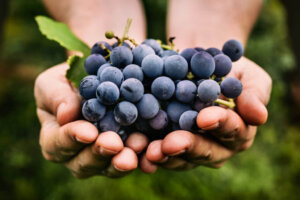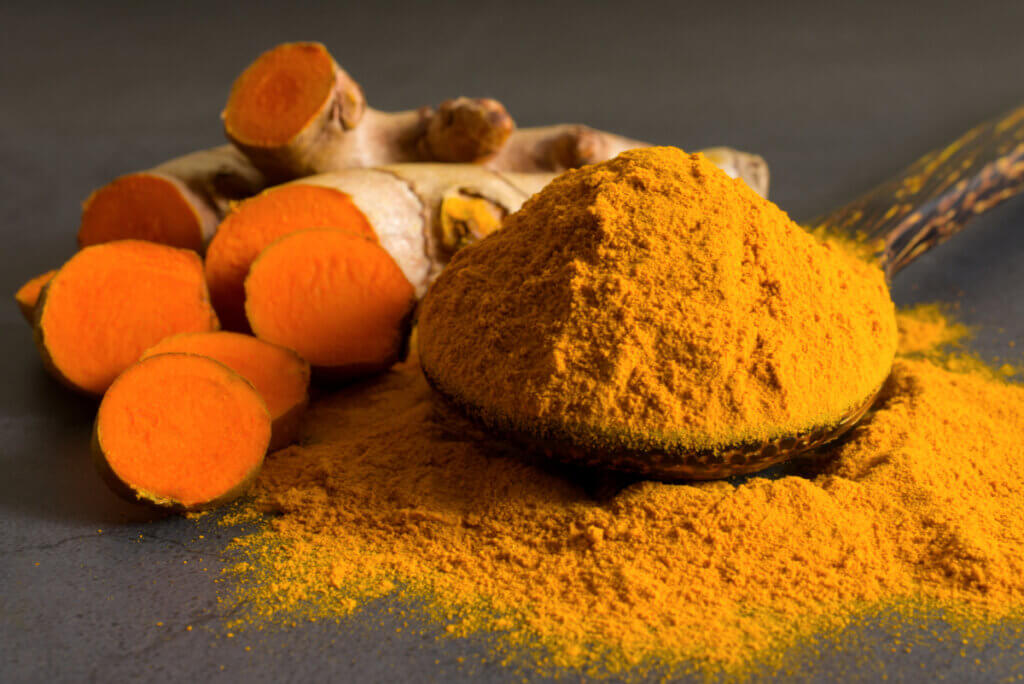Polyphenols: Properties and Types


Escrito y verificado por el nutricionista Saúl Sánchez
Polyphenols are a series of compounds that don’t act as nutrients, but do perform beneficial functions for the body. They are found in foods of plant origin and in recent years they’re gaining a lot of importance. Its consumption is associated with a better state of health.
One of the arguments that support the recommendation of a varied diet is that, by including various types of food, a complete intake of polyphenols is obtained, as well as other non-nutritive substances capable of improving the functioning of body systems, such as fiber.
What are polyphenols?
Polyphenols are a compendium of chemical substances housed in foods of plant origin. Its main characteristic is that it contains more than one phenol group from the chemical point of view.
Mainly tannins, lignins, and flavonoids stand out. Each of them has specific functions.
This series of compounds are characterized by their antioxidant power. This means that they are capable of donating electrons to other molecules in order to keep the reductive oxidation potential balanced. This neutralizes the formation of free radicals typical of metabolic processes. The accumulation of this series of elements could have negative implications, according to a study published in the journal Critical Reviews in Eukaryotic Gene Expression.
In fact, the accumulation of reactive oxygen species at the cellular level is associated with a greater number of mutations, which leads to an increased incidence of pathologies, especially the cardiovascular type.
Benefits of polyphenols
Regular consumption of foods of plant origin has been shown to exert a protective effect on the human body. They help towards increasing life expectancy and reducing the risk of developing complex pathologies. This property is due, in part, to the polyphenol content.
Polyphenols are able to modulate oxidation in the body and reduce premature aging, as confirmed by research published in the journal Nutrients. These compounds delay cognitive decline and neutralize the effects of free radicals on cells and tissues.
There’s even evidence that these substances are able to help prevent various types of cancer. In addition, they act by reducing tissue inflammation, which is an added bonus in the case of athletes’ diets. The regular intake of polyphenols is associated with better muscular performance and a lower risk of injury in intense work sessions.

Types of polyphenols
As we mentioned, there are 3 different types of polyphenols: tannins, lignins, and flavonoids. The former stand out for their effects on the cardiovascular system. They’re capable of reducing blood pressure levels and the oxidation of VLDL series lipoproteins, generating greater efficiency in the functioning of the heart.
Lignins are compounds responsible for giving turgidity and rigidity to the cell wall of plant cells. Its intake can cause a lower intestinal absorption of certain nutrients or substances, such as cholesterol. They’re also capable of interacting with bile acids, improving their function.
Finally, flavonoids stand out for their anti-inflammatory power and their ability to reduce the incidence of complex pathologies, according to a study published in the Journal of Medicinal Food. Some of them have demonstrated their effectiveness in preventing neurodegenerative disorders.
Foods that contain polyphenols
We’re going to review the foods that have a higher content of these substances, so they should be common ingredients in almost any healthy diet.
Grapes
Grapes are one of the fruits that contain the highest amount of polyphenols. Specifically, they have a high amount of tannins capable of exerting benefits on cardiovascular health. In fact, regular intake of grapes has been linked to a lower risk of heart attacks.
However, it should be noted that drinking wine isn’t the same as consuming grapes. Despite the fact that, for many years, the moderate consumption of wine was defended, you should know that the potency of the tannins in this case is much lower. Polyphenols tend to oxidize through the fermentation processes that take place in the barrel.
In addition, wine has a toxic substance, alcohol, which has been shown to be harmful to the body regardless of the amount consumed. For this reason, it is advisable to consume grapes, but not their derivatives.
Berries
Red berries or forest fruits have also been recognized for their polyphenol content. Specifically, they have a flavonoid, anthocyanins, which are able to prevent the development of many complex pathologies.
There is evidence that these types of compounds are useful in the treatment of various inflammatory pathologies, thanks to their ability to neutralize the formation of reactive oxygen species.
Among the red fruits, blueberries stand out above the rest. However, cherries, strawberries, currants, and raspberries also have anthocyanins in their composition. Even some dark-colored vegetables do, such as red cabbage, eggplant, and beets.
You should keep in mind that anthocyanins are nothing more than pigments responsible for the dark, reddish, and purple coloration of many vegetables. Therefore, whenever you consume a vegetable with this organoleptic characteristic, you will be ingesting a good number of polyphenols.
Culinary spices
In recent times, the frequent use of culinary spices has begun to be recommended. Most of these that are used regularly have said compounds. However, turmeric stands out above the rest. This seasoning has a polyphenol, curcumin.
At present, capsules have been made with curcumin itself that are marketed as a dietary supplement. These supplements usually contain around 1 gram of the polyphenol, which is the recommended amount.
Cruciferous vegetables
We couldn’t talk about polyphenols and the foods that contain them without making special mention of cruciferous vegetables. In this group we find broccoli, cauliflower, and romanesco. It’s a group of vegetables that contain high amounts of water, fiber, and phytonutrients.
Some of the representatives of this last group have proven to be effective for the treatment of certain pulmonary pathologies. Sulforaphane stands out for its ability to regulate and promote tumor cell apoptosis. However, this doesn’t mean that it’s a miracle food or that it should replace the pharmacological approach. It would be a product capable of complementing chemotherapy.

It’s important to include food containing polyphenols in your diet
Regular consumption of polyphenols can reduce inflammation levels in your body. For this reason, any healthy diet must contain a high number of vegetables in its composition, prioritizing those with bright colors and culinary spices.
It’s also important to avoid the intake of toxic substances such as alcohol. Such compounds could tip the scales to the side of producing free radicals, which would be considered harmful.
There are even other drinks that can be regularly included in the diet with the aim of increasing its quality and health. Examples would be tea, coffee, and cocoa.
It is crucial to consume the 3 types of polyphenols that exist in order to guarantee the proper functioning of the body. However, perhaps the flavonoids stand out above the rest because they are a broader group. In fact, almost all fruits and vegetables contain at least one representative of this group.
Polyphenols are a series of compounds that don’t act as nutrients, but do perform beneficial functions for the body. They are found in foods of plant origin and in recent years they’re gaining a lot of importance. Its consumption is associated with a better state of health.
One of the arguments that support the recommendation of a varied diet is that, by including various types of food, a complete intake of polyphenols is obtained, as well as other non-nutritive substances capable of improving the functioning of body systems, such as fiber.
What are polyphenols?
Polyphenols are a compendium of chemical substances housed in foods of plant origin. Its main characteristic is that it contains more than one phenol group from the chemical point of view.
Mainly tannins, lignins, and flavonoids stand out. Each of them has specific functions.
This series of compounds are characterized by their antioxidant power. This means that they are capable of donating electrons to other molecules in order to keep the reductive oxidation potential balanced. This neutralizes the formation of free radicals typical of metabolic processes. The accumulation of this series of elements could have negative implications, according to a study published in the journal Critical Reviews in Eukaryotic Gene Expression.
In fact, the accumulation of reactive oxygen species at the cellular level is associated with a greater number of mutations, which leads to an increased incidence of pathologies, especially the cardiovascular type.
Benefits of polyphenols
Regular consumption of foods of plant origin has been shown to exert a protective effect on the human body. They help towards increasing life expectancy and reducing the risk of developing complex pathologies. This property is due, in part, to the polyphenol content.
Polyphenols are able to modulate oxidation in the body and reduce premature aging, as confirmed by research published in the journal Nutrients. These compounds delay cognitive decline and neutralize the effects of free radicals on cells and tissues.
There’s even evidence that these substances are able to help prevent various types of cancer. In addition, they act by reducing tissue inflammation, which is an added bonus in the case of athletes’ diets. The regular intake of polyphenols is associated with better muscular performance and a lower risk of injury in intense work sessions.

Types of polyphenols
As we mentioned, there are 3 different types of polyphenols: tannins, lignins, and flavonoids. The former stand out for their effects on the cardiovascular system. They’re capable of reducing blood pressure levels and the oxidation of VLDL series lipoproteins, generating greater efficiency in the functioning of the heart.
Lignins are compounds responsible for giving turgidity and rigidity to the cell wall of plant cells. Its intake can cause a lower intestinal absorption of certain nutrients or substances, such as cholesterol. They’re also capable of interacting with bile acids, improving their function.
Finally, flavonoids stand out for their anti-inflammatory power and their ability to reduce the incidence of complex pathologies, according to a study published in the Journal of Medicinal Food. Some of them have demonstrated their effectiveness in preventing neurodegenerative disorders.
Foods that contain polyphenols
We’re going to review the foods that have a higher content of these substances, so they should be common ingredients in almost any healthy diet.
Grapes
Grapes are one of the fruits that contain the highest amount of polyphenols. Specifically, they have a high amount of tannins capable of exerting benefits on cardiovascular health. In fact, regular intake of grapes has been linked to a lower risk of heart attacks.
However, it should be noted that drinking wine isn’t the same as consuming grapes. Despite the fact that, for many years, the moderate consumption of wine was defended, you should know that the potency of the tannins in this case is much lower. Polyphenols tend to oxidize through the fermentation processes that take place in the barrel.
In addition, wine has a toxic substance, alcohol, which has been shown to be harmful to the body regardless of the amount consumed. For this reason, it is advisable to consume grapes, but not their derivatives.
Berries
Red berries or forest fruits have also been recognized for their polyphenol content. Specifically, they have a flavonoid, anthocyanins, which are able to prevent the development of many complex pathologies.
There is evidence that these types of compounds are useful in the treatment of various inflammatory pathologies, thanks to their ability to neutralize the formation of reactive oxygen species.
Among the red fruits, blueberries stand out above the rest. However, cherries, strawberries, currants, and raspberries also have anthocyanins in their composition. Even some dark-colored vegetables do, such as red cabbage, eggplant, and beets.
You should keep in mind that anthocyanins are nothing more than pigments responsible for the dark, reddish, and purple coloration of many vegetables. Therefore, whenever you consume a vegetable with this organoleptic characteristic, you will be ingesting a good number of polyphenols.
Culinary spices
In recent times, the frequent use of culinary spices has begun to be recommended. Most of these that are used regularly have said compounds. However, turmeric stands out above the rest. This seasoning has a polyphenol, curcumin.
At present, capsules have been made with curcumin itself that are marketed as a dietary supplement. These supplements usually contain around 1 gram of the polyphenol, which is the recommended amount.
Cruciferous vegetables
We couldn’t talk about polyphenols and the foods that contain them without making special mention of cruciferous vegetables. In this group we find broccoli, cauliflower, and romanesco. It’s a group of vegetables that contain high amounts of water, fiber, and phytonutrients.
Some of the representatives of this last group have proven to be effective for the treatment of certain pulmonary pathologies. Sulforaphane stands out for its ability to regulate and promote tumor cell apoptosis. However, this doesn’t mean that it’s a miracle food or that it should replace the pharmacological approach. It would be a product capable of complementing chemotherapy.

It’s important to include food containing polyphenols in your diet
Regular consumption of polyphenols can reduce inflammation levels in your body. For this reason, any healthy diet must contain a high number of vegetables in its composition, prioritizing those with bright colors and culinary spices.
It’s also important to avoid the intake of toxic substances such as alcohol. Such compounds could tip the scales to the side of producing free radicals, which would be considered harmful.
There are even other drinks that can be regularly included in the diet with the aim of increasing its quality and health. Examples would be tea, coffee, and cocoa.
It is crucial to consume the 3 types of polyphenols that exist in order to guarantee the proper functioning of the body. However, perhaps the flavonoids stand out above the rest because they are a broader group. In fact, almost all fruits and vegetables contain at least one representative of this group.
- Sharma GN., Gupta G., Sharma P., A comprehensive review of free radicals, antioxidants, and their relationship with human aliments. Crit Rev Eukaryot Gene Expr, 2018. 28 (2): 139-154.
- Hernández, Nicolás Pedreros. “Beneficios de las verduras crucíferas para la salud humana.”
- Aune D., Giovannucci E., Boffetta P., Fadness LT., et al., Fruit and vegetable intake and the risk of cardiovascular disease, total cancer and all cause mortality a systematic review and dose response meta analysis of prospective studies. Int J Epidemiol, 2017. 46 (3): 1029-1056.
- Serino A., Salazar G., Protective role of polyphenols against vascular inflammtion, aging and cardiovascular disease. Nutrients, 2018.
- Zhou Y., Zheng J., Li Y., Xu DP., et al., Natural polyphenols for prevention and treatment of cancer. Nutrients, 2016. 22 (8): 515.
- Jung UJ., Kim SR., Beneficial effects of flavonoids against parkinson’s disease. J Med Food, 2018. 21 (5): 421-432.
- Li BW., Gong CC., Song HF., Cui YY., Effects of anthocyanins on the prevention and treatment of cancer. Br J Pharmacol, 2017. 174 (11): 1226-1243.
Este texto se ofrece únicamente con propósitos informativos y no reemplaza la consulta con un profesional. Ante dudas, consulta a tu especialista.







